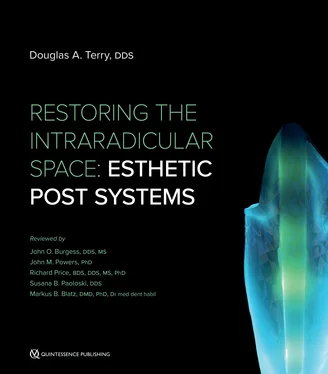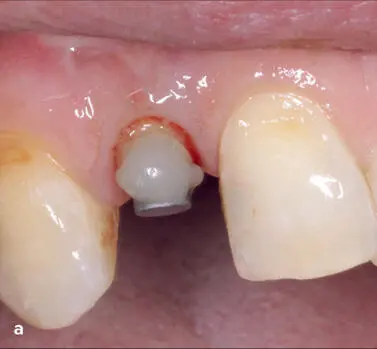
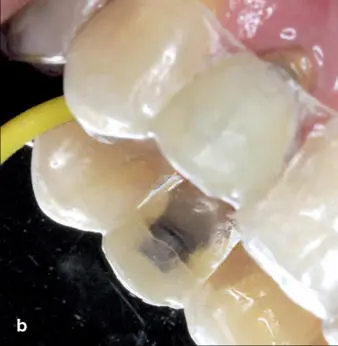
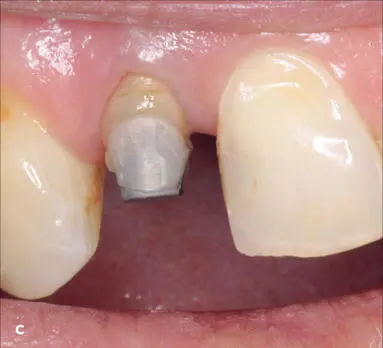
Fig 1-25 (a to c) After endodontic therapy and placement of a fiber-reinforced post on the maxillary right lateral incisor, orthodontic extrusion was accomplished using magnets. (Dentistry courtesy of Abdelrahman Awadin, BDS.)

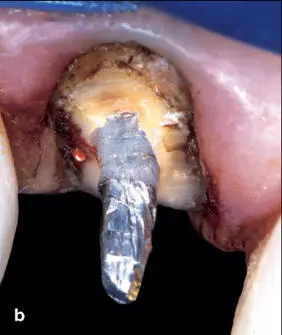
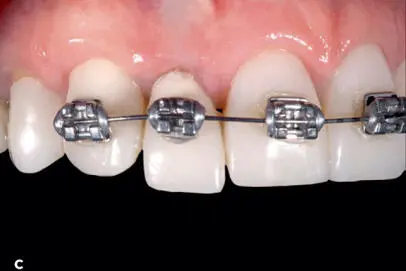
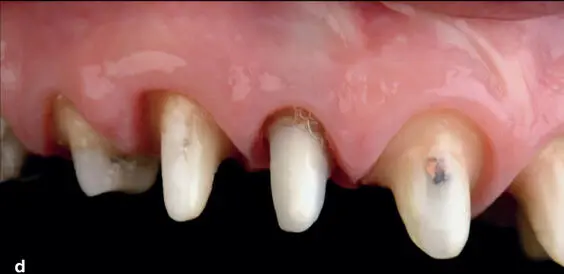
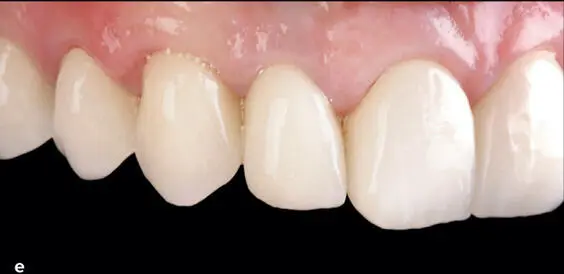
Fig 1-26 Orthodontic extrusion can be used to establish an optimal ferrule height, biologic width space, and an ideal gingival architecture. (a and b) During previous treatment, the endodontically treated maxillary right lateral incisor had insufficient ferrule height, and the restorative margin was placed in violation of the biologic width. (c and d) Orthodontic brackets were placed on the provisional restorations, and the maxillary lateral incisor was extruded to attain a ferrule dimension of 1.5 mm and to establish a biologic width of 3 mm. The more rapid the movement, the less likely it is to extrude the supporting structures. (e) Note the healthy biologic framework achieved by attaining a restorative dimension of 4.5 mm of supracrestal tooth structure. For more information, see chapter 2, Case 1.
In comparing the two methods, orthodontic extrusion generally preserves more hard and soft tissue, provides a more preferable crown-to-root ratio, and creates a more favorable biomechanical behavior. One study reported that orthodontic extrusion provided a better prognosis than surgical crown lengthening.301 There are factors that contribute to a poor prognosis, which include an inadequate root length, insufficient coronal tooth structure, and an inadequate crown-to-root ratio. Accordingly, if neither of these alternative methods can alter these factors, poor long-term treatment outcomes are to be expected.301 ,541
PRESERVATION OR REPLACEMENT OF THE NATURAL TOOTH
A frequent dilemma that is often juxtaposed is the concern for preserving or replacing a compromised natural tooth.630 ,631 Dental implants provide an appropriate alternative in replacing teeth that cannot be treated with a predictable and favorable prognosis.632 However, today many compromised teeth are extracted and replaced with an implant with limited consideration for the vast reconstructive options that are available to restore and maintain them.346 This extraction-oriented reconstructive concept346 may be founded on the misconception that ETT have been considered inferior to implants in regard to long-term stability and retention.633 ,634 This misinformation is the catalyst that ignites the confusion in regard to success or survival outcomes of implants and endodontics.633 Nevertheless, contemporary dentistry should follow an evidence-based approach.633 ,635 Studies have demonstrated that endodontic and implant therapies have provided similar long-term results.631 One meta-analysis indicated that there was no significant difference in success rates between restored single implants (95%) and ETT (94%) over 6 years.636 Another study reported a positive outcome of 74% for implants and 84% for ETT. However, in this study, the rate of complications and required interventions was significantly higher in the implant group, and it required a longer period of time for the patients to adjust to the implant restoration.637 Another review indicated that evidence exists that the failure rate of implants is higher than that of natural teeth in clinically well-maintained patients.635 Furthermore, there is evidence that restorations on implants have a lower life expectancy over 5 to 10 years than the implants themselves.155 Other long-term studies report high success rates with modern endodontic microsurgery.638 –641 Thus, numerous studies and publications have debated and reviewed this conundrum of preservation by nonsurgical and surgical endodontic methods, or whether an extraction and replacement with an implant is more beneficial in the long-term.535 ,634 ,642 –653
Today, many teeth are replaced with implants because this procedure is considered simple, requires a shorter treatment time, and is more lucrative than preserving a natural tooth that may require more knowledge and advanced training for an optimal interdisciplinary treatment strategy.633 ,654 Also, this self-limiting direction may be responsible for the narrower views that exclude other disciplines of dentistry.633 The development of modern techniques and materials with advanced technology in all disciplines of dentistry should allow for the preservation and maintenance of natural teeth. The concept of less invasive to more invasive as time requires should be the philosophy of our profession. Thus, each discipline should complement and not compete for the long-term health and benefit of the patient.633 Regardless of the selected treatment of preserving or replacing natural teeth with implants, the patient should be part of the restorative solution.196
CONCLUSION
Although the quest for the ideal material to restore lost tooth structure continues to be a focus of dental research, the modern philosophy of preservation of tooth structure, the existence of a ferrule effect, and the formation and maintenance of a quality adhesive bond 70are the prerequisites for achieving long-term success of the restorative procedure of ETT. 29 , 42 , 43 , 100 ,201 ,289 Researchers report that conservation of tooth structure for ETT is as essential as selecting the appropriate biomaterials for developing the most optimal biomechanical behavior.185
Clinicians and technicians are confronted with myriad materials and techniques for restoring ETT, while also being overwhelmed with material-oriented and confusing in vitro studies that are not comparable655 ,656 and sometimes lack accepted clinical standards. 29Therefore, many times the information obtained from these studies is not useful for making clinical decisions657 during treatment planning or when informing patients of their restorative options. An understanding of general design criteria and evaluation of the components of the various post and core systems available for the reconstruction of the tooth-restorative complex allow the clinician to select an appropriate system for the restorative management of ETT for each clinical situation. Thus, as the industry continues to develop improved methods and materials, the clinician should be encouraged to use the aforementioned general principles as a guide while exploring new materials and techniques. However, as with most procedures, each clinical situation should be evaluated on an individual basis 1using clinical experience and judgment based on scientific evidence to provide the final decision for application.
Читать дальше
